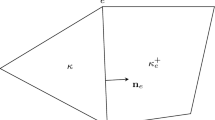Abstract
We study the multiphasic formulation of the incompressible Euler equation introduced by Brenier: infinitely many phases evolve according to the compressible Euler equation and are coupled through a global incompressibility constraint. In a convex domain, we are able to prove that the entropy, when averaged over all phases, is a convex function of time, a result that was conjectured by Brenier. The novelty in our approach consists in introducing a time-discretization that allows us to import a flow interchange inequality previously used by Matthes, McCann and Savaré to study first order in time PDE, namely the JKO scheme associated with non-linear parabolic equations.
Similar content being viewed by others
Notes
Let us precise that this idea is adapted from an ongoing work [14] with Filippo Santambrogio where the same kind of technique is used to provide regularity for solutions of quadratic Mean Field Games.
Strictly speaking, in [12], it is required that \(\Omega \) has a piecewise \(C^1\) boundary, but this assumption is only used to prove that the Minkowski functional of \(\Omega \) is Lipschitz. If \(\Omega \) is convex, then its Minkowski functional is convex, hence Lipschitz. Thus, one can drop the assumption of a piecewise \(C^1\) boundary if \(\Omega \) is convex.
One may worry about the non uniqueness of the geodesic and hence of the fact that the extension operator \(E_N\) is ill-defined. However, it is a classical result of optimal transport that the constant-speed geodesic joining two measures is unique as soon as one of the two measures is absolutely continuous w.r.t. \(\mathcal {L}\). Moreover, for a traffic plan \(Q \in \mathcal {P}(\Gamma _{T^N})\), if \(H_Q(t) < + \infty \) for \(t \in T^N\), then Q-a.e. \(\rho \) is absolutely continuous w.r.t. \(\mathcal {L}\) at time t. Thus as long as we work with \(W_2\)-traffic pans Q such that \(H_Q(k \tau ) < + \infty \) for any \(k \in \{ 1,2, \ldots , N-1 \}\) (and we leave it to the reader to check that it is the case), the operator \(E_N\) is well defined.
References
Ambrosio, L., Figalli, A.: Geodesics in the space of measure-preserving maps and plans. Arch. Ration. Mech. Anal. 194(2), 421–462 (2009)
Ambrosio, L., Gigli, N., Savaré, G.: Gradient Flows in Metric Spaces and in the Space of Probability Measures. Birkhäuser Verlag, Basel (2008)
Ambrosio, L., Tilli, P.: Topics on Analysis in Metric Spaces. Oxford Lecture Series in Mathematics and Its Applications, vol. 25. Oxford University Press, Oxford (2004)
Arendt, W.: Semigroups and evolution equations: functional calculus, regularity and kernel estimates. Handb. Differ. Equ. Evol. Equ. 1, 1–85 (2002)
Arnold, V.: Sur la géométrie différentielle des groupes de Lie de dimension infinie et ses applications à l’hydrodynamique des fluides parfaits. Annales de l’institut Fourier 16, 319–361 (1966)
Bernot, M., Caselles, V., Morel, J.-M.: Traffic plans. Publicacions Matemàtiques 49(2), 417–451 (2005)
Bernot, M., Figalli, A., Santambrogio, F.: Generalized solutions for the Euler equations in one and two dimensions. Journal de mathématiques pures et appliquées 91(2), 137–155 (2009)
Brenier, Y.: The least action principle and the related concept of generalized flows for incompressible perfect fluids. J. Am. Math. Soc. 2(2), 225–255 (1989)
Brenier, Y.: Minimal geodesics on groups of volume-preserving maps and generalized solutions of the Euler equations. Commun. Pure Appl. Math. 52(4), 411–452 (1999)
Brenier, Y.: Extended Monge-Kantorovich theory. In: Optimal Transportation and Applications, pp 91–121. Springer (2003)
Daneri, S., Figalli, A.: Variational models for the incompressible Euler equations. HCDTE Lecture Notes. Part II. Nonlinear Hyperbolic PDEs, Dispersive and Transport Equations. AIMS Book Series, Applied Mathematics (2012)(to appear)
Fonseca, I., Parry, G.: Equilibrium configurations of defective crystals. Arch. Ration. Mech. Anal. 120(3), 245–283 (1992)
Jordan, R., Kinderlehrer, D., Otto, F.: The variational formulation of the Fokker–Planck equation. SIAM J. Math. Anal. 29(1), 1–17 (1998)
Lavenant, H., Santambrogio, F.: Optimal density evolution with congestion: \(L^\infty \) bounds via flow interchange techniques and applications to variational Mean Field Games. arXiv preprint arXiv:1705.05658 (2017)
Matthes, D., McCann, R.J., Savaré, G.: A family of nonlinear fourth order equations of gradient flow type. Commun. Partial Differ. Equ. 34(11), 1352–1397 (2009)
Pierre, M.: Uniqueness of the solutions of \(u_t- \Delta \phi (u)= 0\) with initial datum a measure. Nonlinear Anal. Theory Methods Appl. 6(2), 175–187 (1982)
Santambrogio, F.: Optimal transport for applied mathematicians. In: Birkhäuser Basel (ed) Progress in Nonlinear Differential Equations and their applications, vol. 87 (2015)
Santambrogio, F.: \(\big \{\)Euclidean, Metric, and Wasserstein\(\big \}\) Gradient Flows: an overview. Preprint http://cvgmt.sns.it/paper/3165/ (2016)
Villani, C.: Topics in Optimal Transportation, vol. 58. American Mathematical Soc, Providence (2003)
Acknowledgements
The author acknowledges the support of ANR project ISOTACE (ANR-12-MONU-0013). He also thanks Filippo Santambrogio, Aymeric Baradat, Paul Pegon and Yann Brenier for fruitful discussions and advice.
Author information
Authors and Affiliations
Corresponding author
Additional information
Communicated by L. Ambrosio.
Rights and permissions
About this article
Cite this article
Lavenant, H. Time-convexity of the entropy in the multiphasic formulation of the incompressible Euler equation. Calc. Var. 56, 170 (2017). https://doi.org/10.1007/s00526-017-1262-1
Received:
Accepted:
Published:
DOI: https://doi.org/10.1007/s00526-017-1262-1



